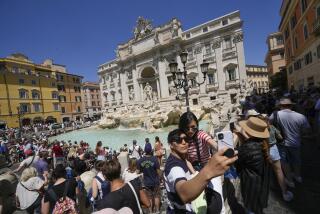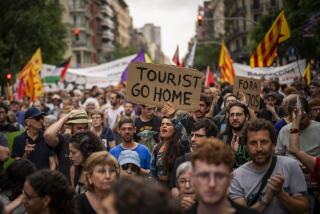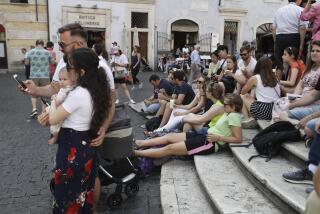The ethics of disaster tourism: What is the right thing to do? [Updated]
Removal of fuel from the Costa Concordia, which ran aground last month off Tuscany, began last week and officials say that after it’s gone, it may take seven to 10 months to refloat the ship.
Meanwhile, Tuscan tourism officials are urging tourists to visit eight-square-mile Giglio, off whose coast the ship ran aground on Jan. 13, as a “gesture of love.”
Not long after the accident, which killed at least 17 people (15 are still missing), islanders said people came to Giglio to gawk and not because of their affection for Giglio, one of seven islets in the Tuscan Archipelago.
All of which raises this question: Is it love or is it lewd to visit a place after a disaster?
After a recent story in the Travel section reported that some residents of Joplin were angered by a map showing where a tornado devastated the southwestern Missouri town last spring, we asked ethicists about tourism in the aftermath of tragedy.
Wanting to see a place where disaster has struck is not always a sign of insensitivity, said Patricia Illingworth, an ethics professor at Northeastern University, a lawyer and a lecturer in law at Northeastern University School of Law and author of “Us Before Me, Ethics and Social Capital for Global Well Being.”
“I think that there’s a lot of benefit from going,” she said of seeing the aftermath, adding that “gawking … obviously isn’t a good idea.” But, she added, “going and seeing what the people are suffering or seeing the situation, that then raises empathy or allows us to empathize” with the situation, she said.
Fundraisers, for instance, often have at their core human suffering, she noted. And you know those ads featuring emaciated children? Calling this the “pornography of poverty,” Illingworth noted that such images stimulate empathy, which often results in action.
But some may object. “Some local residents may find it embarrassing or offensive for outsiders to ooh and ahh and take pictures of a broken community,” said Dr. Tanvir Hussain, a Los Angeles cardiologist and adjunct professor of bioethics at Pepperdine University School of Law. “On the other hand, local businesses [that] thrive off of visitors, such as restaurants and hotels, may welcome outsiders at a time when little business from locals is to be had.”
The issue of disaster tourism isn’t new. After Hurricane Katrina in 2005, companies began offering tours of areas that were especially hard hit after the storm and the levee failures. After the Indian Ocean tsunami of 2004, photos showed tourists sunbathing on Asian beaches while cleanup continued in the background. More than 200,000 people were killed in that calamity, many ripped from the arms of loved ones and swept to their deaths. Some thought the sunbathers insensitive.
“There are really two sides to the issue, one principled, and the other practical, but both making valid points,” Hussain said. “The principled view finds disaster tourism fundamentally exploitative, bringing in the wealthy and healthy to gawk at scenes of destruction, and those less fortunate who are struggling to rebuild their lives. The other side makes a practical point, stating that exposure will truly inform outsiders of the degree of devastation and hardship experienced by a community, while bringing in income from tourism and increased donations.”
There is no clear answer as to whether or even when you should go, although time will help with that latter question. Illingworth reminded me that people today visit Auschwitz, the concentration camp in Nazi-occupied Poland where as many as 1.5 million prisoners, most of them Jews, died in World War II. The visitation would have seemed almost unthinkable in the aftermath of a war that saw 6 million Jews perish as part of the “final solution.”
[For the Record, 2:45 p.m. Feb. 22: An earlier version of this article referred to Auschwitz as a Polish concentration camp. It was a Nazi concentration camp in Poland run by German Nazis.]
In 1979, UNESCO declared Auschwitz a World Heritage Site, noting, “The site is a key place of memory for the whole of humankind for the Holocaust, racist policies and barbarism; it is a place of our collective memory of this dark chapter in the history of humanity, of transmission to younger generations and a sign of warning of the many threats and tragic consequences of extreme ideologies and denial of human dignity.”
Travel, at its core, is supposed to broaden our experience and make us think beyond our own horizons. A visit to a place of barbarism that once may have been unthinkable can now provide a painful but important lesson.
Yet those whose lives are touched by misfortune, although none on the scale of the Holocaust, may object to becoming unintended teachers.
“A couple of years ago when the Iceland volcano exploded, I was stranded in Nairobi, Kenya, for several days awaiting my flight through Europe and back to the U.S.,” Hussain said. “While there, I visited the Kibera slum … taking pictures during my day there, but being careful so as not to offend and asking permission when the opportunity arose.
“Still, I was aware of the debate around this issue and experienced it firsthand, with some locals who took offense at my presence and yelling at me ... to leave, while others welcomed us by telling their stories and showing us their living conditions. I volunteered for a day and donated to a local charity as a result of my visit.”
And that may be the best solution, both experts agree. Volunteering offers the opportunity to see what’s happened while being of use to the people who need your help most — the convergence, perhaps, of the principled and practical.
“More and more, our nation and our world must look to volunteers to fill the gaps that governments are unwilling or unable to fill — in health care, education and programs for the disabled and underprivileged,” Ed Asner writes in the foreword to the just-published 11th edition of “Volunteer Vacations: Short-Term Adventures that Will Benefit You and Others,” by Bill McMillon, Doug Cutchins and Anne Geissinger. The book gives details on volunteering around the globe and shows how acting, rather than simply reacting, may be the gift of a “key place of memory” that becomes part of not just who we are but who we can become.
More to Read
Sign up for The Wild
We’ll help you find the best places to hike, bike and run, as well as the perfect silent spots for meditation and yoga.
You may occasionally receive promotional content from the Los Angeles Times.






